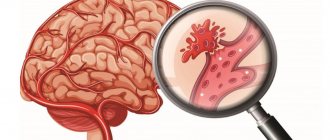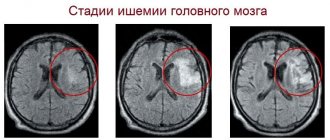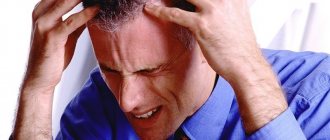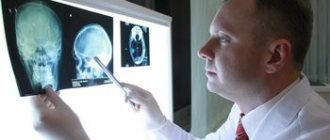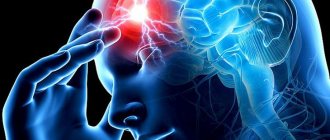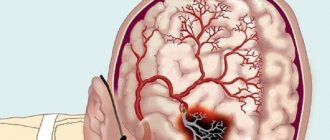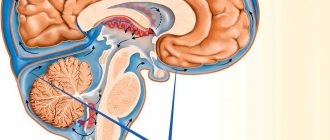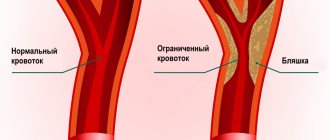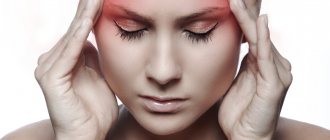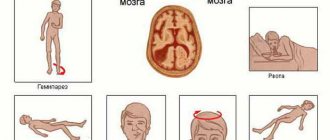Ischemic stroke is a sudden disruption of brain tissue caused by a cerebrovascular accident. It is important to determine the course of the disease in time and receive treatment. The risk of occurrence depends on lifestyle, heredity, gender and age of the patient, as well as the presence of chronic diseases. You should know in advance what ischemic stroke is, its symptoms, consequences and treatment. At the first signs of illness, you should consult a doctor.
Classification
There are several classifications of ischemic brain damage depending on different aspects and localization of the infarction zone. They differ:
- by the rate of formation and duration of neurological damage;
- according to the severity of the patient’s condition;
- by pathogenesis;
- according to the location of cerebral infarction.
Expert opinion
Author: Georgy Romanovich Popov
Neurologist, Candidate of Medical Sciences
Ischemic stroke occurs due to a temporary disruption of the patency of the blood vessels of the brain as a result of hypertensive attacks and atherosclerosis. This is one of the pathological conditions that require immediate hospitalization of the patient.
In accordance with the symptoms, doctors quickly determine the type of disease:
- a right-sided stroke is characterized by complete paralysis of the entire left side of the body;
- left-sided - paralysis of the right side of the body, impaired speech function, the ability to perceive it;
- stem disease occurs in the brain stem, the damage spreads to the centers responsible for visual, respiratory functions and heart function. Symptoms include uncoordination of movements, dizziness;
- cerebellar is determined by a lack of coordination, attacks of dizziness, and numbness of the facial muscles.
The consequences of ischemic stroke are always severe. The main ones include mental disorders, impaired sensitivity in the muscles of the limbs, motor function and speech, swallowing, and coordination. Up to 10% of stroke patients suffer from epilepsy. Doctors at the Yusupov Clinic conduct a rapid examination of patients with suspected ischemic stroke. Based on the diagnosis, complex therapy is prescribed using modern equipment, innovative and traditional methods.
Stages of ischemic stroke
In total, doctors distinguish four stages of completed ischemic stroke:
- The most acute period occurs in the first three days from the onset of the attack. In the very first minutes, symptoms characteristic of the disease develop: weakness, partial paralysis of the body, headaches and disorientation in space, vomiting, nausea, ripples in the eyes, dizziness. During this period, the patient experiences hearing and speech impairment, spasms and muscle relaxation. If the symptoms go away on their own within 24 hours, an ischemic attack is diagnosed.
- The acute period is determined by the time interval between the third and 21st days from the onset of the disease. The main listed signs of ischemic stroke gradually disappear.
- The early recovery period begins on the 21st day from the onset of the stroke and lasts up to 6 months. If active recovery is carried out during this stage, then previously lost functions return almost completely.
- The period of late recovery occurs from the 6th month to the 24th month from the moment of the attack. With proper rehabilitation, body functions continue to be actively restored to the maximum limit. If necrosis has not occurred, functionality can be restored completely.
Infarction of the subdominant hemisphere
If an infarction of the subdominant hemisphere occurs, then the disease will be characterized by emotional disturbances and spatial non-response.
How much paresis will spread during a heart attack into the cavity of the blood supply (striatocapsular arteries) will depend on the location and area of the lesion itself (usually the upper part of the body: face, limbs or cotralateral part of the body). Speaking about an extensive infarction of the striatocapsular type, the main symptom is occlusion of the cerebral (middle) artery, which is expressed in aphasia or homonymous lateral hemianopia.
Causes and factors for the development of a life-threatening condition
Risk factors for heart and vascular disease are similar in many ways. Conventionally, they can be divided into internal and external.
Internal factors are considered:
- diabetes;
- excess body weight;
- gender, since it was found that in men the disease occurs at a slightly earlier age than in women;
- age, since stroke is diagnosed more often in older people;
- heredity, manifested in the presence of hypertension, stroke, or a history of heart attack in close relatives.
External risk factors include:
- Climate and time of year. There is a direct dependence of ischemic stroke on the time of year and weather conditions. The most unfavorable periods are the winter and spring seasons, when there are often sudden changes in weather, large amounts of precipitation, and fluctuating atmospheric pressure and air temperature. It is at such moments that cerebral circulation disorders become more frequent.
- Smoking. An addiction doubles the risk of heart and vascular diseases. Due to the influence of nicotine and many other substances, the composition of the blood changes, blood pressure increases and the heart rate increases. The heart of a smoker makes more contractions than a non-smoker, which leads to premature wear of the heart muscle.
- Inactive lifestyle. Insufficient physical activity has a detrimental effect on human health, leading to obesity, the development of arterial hypertension, diabetes, multiple excess cholesterol levels, which contributes to the formation of cholesterol plaques and blood clots, increasing the risk of circulatory disorders in the brain.
- Regular alcohol consumption. Most often, strokes in young people occurred while they were intoxicated. Systematic consumption of alcohol in large quantities leads to cerebral hemorrhages and cerebral infarction.
- Emotional stress. Overstrain of the nervous system changes the biochemical composition of the blood, the level of electrolytes and leads to oxygen starvation of the vascular wall, which threatens subsequent changes.
Pathogenesis
A certain sequence of molecular biochemical changes in the brain substance, caused by acute focal cerebral ischemia, can lead to tissue damage, resulting in cell death (cerebral infarction). The nature of the changes depends on the level of decrease in cerebral blood flow, the duration of this decrease and the sensitivity of the brain substance to ischemia. The degree of reversibility of tissue changes at each stage of the pathological process is determined by the level of decrease in cerebral blood flow and its duration in combination with factors that determine the sensitivity of the brain to hypoxic damage.
The term “infarction core” refers to a zone of irreversible damage, and the term “ischemic penumbra” (penumbra) refers to a zone of reversible ischemic damage. The duration of the penumbra's existence is the most important point, since over time, reversible changes become irreversible. The oligemic zone is a zone in which a balance is maintained between tissue needs and the processes that provide these needs, despite the decrease in cerebral blood flow. It is capable of existing for an indefinitely long time without passing into the core of the infarction, therefore it is not classified as a penumbra.
Symptoms of ischemic stroke
The most obvious and first harbinger of ischemic stroke is a sharp increase in blood pressure. Further symptoms of ischemic stroke develop very quickly. The most typical symptoms of ischemic cerebral stroke:
- loss of speech clarity;
- lack of coordination in space;
- muscle weakness.
Disturbances in the musculoskeletal system signal damage to the brain, which occurred due to blockage of a cerebral artery. In addition to typical symptoms, the patient may experience:
- sudden and severe headaches;
- nausea;
- vomit;
- dizziness.
However, speech and coordination disorders occur rapidly. They are often used to diagnose a disease, the treatment of which should begin immediately. You should definitely know the symptoms of ischemic heart stroke, as the consequences can be disastrous.
Coma with OI
Sometimes extensive strokes lead to coma, this occurs in cases of massive hemorrhages.
Loss of consciousness occurs, and the patient cannot come to his senses. He does not react to external stimuli, and there is also a lack of reflexes, only swallowing and breathing are preserved. There are frequent cases of arbitrary urination and defecation.
In this state, destructive processes occur in the body, and the longer the patient is in a coma, the more extensive they are.
In the case where coma occurs as a result of a hemorrhagic stroke, most often the patient dies within 24-36 hours due to the development of cerebral edema.
Diagnosis and differential diagnosis
Early diagnosis is of great importance for the correct selection of treatment tactics
ischemic and hemorrhagic stroke. It is worth considering that accurate clinical diagnosis of the nature of the disease is possible only in 70% of cases. To identify the presence of foci of hemorrhagic damage, a patient's medical history is collected, a complete examination, a blood test, a cardiogram, ultrasound of the heart and extracranial arteries, magnetic resonance imaging, computer diagnostics and transcranial Doppler sonography.
Prehospital diagnostics
Prehospital diagnosis ranks first in determining the patient's condition. First of all, the condition of the blood vessels and heart, and respiratory functions are assessed. During a neurological examination, the doctor clarifies the level of consciousness and conducts a typical diagnosis of focal brain lesions.
Instrumental diagnostics
During the acute period of ischemic cerebral infarction, magnetic resonance imaging is performed, as the method is considered the most effective in terms of early visualization. On a standard tomogram, more than 80% of ischemic changes become visible already on the first day of observation.
With computed tomography, a zone of reduced density can be detected 12-24 hours after the development of the disease. If it is less recent, the disease is detected in less than half of the cases. Lacunar infarcts and infarcts in the brain stem are often not detected on non-contrast computed tomography even after 3-5 days.
Differential diagnosis of various types of stroke
In medicine, differential diagnosis is a way to exclude a disease that is inappropriate based on symptoms and factors. This method may require a lumbar puncture. It is carried out only in the absence of contraindications, such as displacement of the midline structures by more than 5 mm. They can be seen using computed tomography or magnetic resonance imaging. In ischemic stroke, the cerebrospinal fluid is clear and contains normal amounts of protein and other cellular elements.
Treatment and rehabilitation
The patient receives treatment in a hospital. All patients with suspected stroke are hospitalized on an emergency basis. The optimal period for providing medical care is the first 3 hours after a brain accident has occurred. The person is placed in the intensive care unit of a neurological hospital. After the acute period has been overcome, he is transferred to the early rehabilitation unit.
Until the diagnosis is established, basic therapy is carried out. The patient’s blood pressure is adjusted, the heart rate is normalized, and the required blood pH level is maintained. To reduce cerebral edema, diuretics and corticosteroids are prescribed. Craniotomy is possible to reduce the degree of compression. If necessary, the patient is connected to an artificial respiration apparatus.
Be sure to direct efforts to eliminate the symptoms of stroke and alleviate the patient’s condition. He is prescribed medications to lower body temperature, anticonvulsants, and antiemetics. Medicines that have a neuroprotective effect are used.
Pathogenetic therapy is based on the type of stroke. In case of ischemic brain damage, it is necessary to restore nutrition to the affected area as quickly as possible. To do this, the patient is prescribed drugs that resolve blood clots. It is possible to remove them mechanically. When thrombolysis fails, the patient is prescribed Acetylsalicylic acid and vasoactive drugs.
If a patient develops a hemorrhagic stroke, it is important to stop the bleeding. To do this, the patient is prescribed drugs that thicken the blood, for example, Vikasol. It is possible to perform an operation to remove the resulting hematoma. It is aspirated using special equipment, or through open access by performing craniotomy.
Relatives and friends should provide support to the patient and not leave him alone with the problem. Psychologists are involved in the work. Sessions with a speech therapist are often required.
Treatment of ischemic stroke
When treating ischemic stroke, it is necessary to act quickly and clearly. In the acute period of the disease, the patient must be urgently hospitalized.
First aid to a patient
Before emergency medical services arrive, you must:
- Place the patient on high pillows.
- Open the window so that there is an influx of fresh air, unbutton the collar of your shirt, take off tight clothes, a belt, a belt.
- Measure blood pressure using a tonometer. If it is elevated, it is necessary to give the patient’s usual medicine or immerse his feet in warm water.
- The patient must take medications that protect nerve cells. For example, drugs-matabolites of brain activity.
It is worth remembering that in case of acute stroke it is prohibited to take any vasodilators. Under their influence, the lumens of blood vessels in undamaged areas of the brain become larger, as a result of which the blood tends to cover all areas, and oxygen starvation begins in the damaged areas.
Drug therapy
Treatment of ischemic stroke should primarily be aimed at restoring damaged areas of the brain and protecting nerve cells. Recovery occurs with the help of a group of drugs such as neuroparants. Healthy nerve cells are protected by neuroprotectors. Some medications combine both of these effects, so they can be used in the complex treatment of ischemic stroke.
In addition to treating nerve tissue, it is also important to pay attention to those diseases that can provoke the disease again. The patient must undergo a full range of studies aimed at controlling dangerous diseases.
Even before hospitalization, the patient receives basic therapy from emergency doctors, which continues in the emergency room. It is necessary to stabilize the patient’s condition and support the performance of systems and organs. Therapy includes:
- Body temperature control. If the value of 37.5°C is exceeded, drugs from the group of analgesics-antipyretics are used.
- Relieving headaches. Nonsteroidal anti-inflammatory medications are administered to relieve pain.
- Relieving cramps, if present.
- Maintaining water and electrolyte balance by administering solutions that maintain blood osmotic pressure.
- Control and adjustment of heart activity.
- Correction of blood pressure.
- Monitoring blood glucose levels.
Specific treatment after ischemic stroke is anticoagulant and thrombolytic therapy.
Drugs for ischemic stroke
Treatment of the disease is based on drugs that thin the blood and dissolve blood clots. Liquefaction of blood clots reduces the level of damage to brain tissue during a major stroke, and also improves the future prognosis for the patient’s health. It makes sense to carry out drug therapy in the first hours after an attack. What to take one year after an ischemic stroke is determined by the attending physician.
Operation
If an ischemic heart stroke is diagnosed, treatment may even include surgery. For example:
- anatomical bypass surgery;
- installation of stent grafts in the carotid artery;
One of the most common ways to reduce the negative consequences of a stroke is thrombolysis. During angiography, medication is injected into the site of the blood clot. Thus, the blockage disappears and normal blood circulation is restored.
Additionally, medications are used that significantly improve metabolic processes in the brain. Therefore, treatment of ischemic stroke is more effective and faster. If the disease is diagnosed on time and the patient receives timely medical care, then there is a high chance that irreversible brain damage has not yet occurred.
Nutritional Features
A patient who has suffered an acute ischemic stroke is very weak at first. Therefore, even ordinary eating or drinking requires enormous effort. For approximately the first three weeks, the patient is fed in a supine or semi-recumbent position. You should start eating with pureed viscous porridges or soups, vegetable purees. Then the diet can be gradually expanded.
Basic principles of nutrition for a patient after a stroke:
- Easily digestible food is given that does not require special energy consumption during digestion;
- food should be nutritious, but low in calories;
- products should not contain cholesterol, or their quantity should be minimal;
- It is prohibited to eat hot or cold food; all dishes must be warm or at room temperature;
- It is recommended to drink from 1.5 to 2 liters of pure water so that the water and electrolyte balance is normal;
- The portion size should be reduced, but the number of meals should be increased;
- Drinking alcohol or smoking is prohibited.
In order for recovery to occur faster, the body must be replenished with macro- and microelements and vitamins. The patient’s diet after suffering a pathology should consist of:
- Vegetables and fruits. They contain a large amount of vitamins. You should consume approximately 400 grams of them daily. Carrots, eggplants, cabbage, cucumbers, tomatoes, beets, pumpkins, apples, bananas, plums, and peaches deserve special attention. It is preferable to eat them baked or boiled; small quantities can be eaten raw.
- Freshly squeezed juices, natural fruit drinks, decoctions of herbs and rose hips, green and weak black tea are the main types of drinks that should be included in the diet.
- Dairy dishes. Cottage cheese and fermented milk dishes will help you forget about constipation. At the same time, it is forbidden to take fatty dairy products: condensed milk, cheese, cream. Dairy products can be consumed 2-3 times a week.
- Low-fat boiled fish. Several times a week, the diet should include salmon, mackerel, sardine, pike, cod, perch, flounder, and navaga.
- Meat products. Meat helps restore nerve cells and helps gain muscle mass. Turkey, rabbit, chicken and veal deserve attention.
- Eggs. It is recommended to use 3-4 pieces per week.
Foods that need to be cooked should be baked or boiled. You can steam it, but avoid fried foods.
It is prohibited to consume soups prepared with fish or meat broth and containing legumes. Porridge and vegetables can be seasoned with vegetable oil.
To add piquancy to the dish, you can add seasonings such as:
- mint;
- rosemary;
- parsley;
- Bay leaf;
- lemon;
- khmeli-suneli;
- dried currant and cherry leaves.
Among sweets, marmalade and biscuits are allowed. The diet can include bread of grades I and II.
How to provide first aid for a stroke
There is a clear algorithm for providing first aid to a person suffering from a stroke :
- Call a medical team . To do this, you need to dial 103 from a landline phone. If you happen to have a smartphone at hand, then the call is made to the single number 112. The doctor must immediately be informed that the person is unwell and there is a suspicion of a stroke.
- The victim must be laid on a flat surface so that his head is higher than his body. They take off his glasses and remove his lenses. If possible, you need to help him get removable dentures.
- If there is no consciousness, then you need to open the patient’s mouth slightly and turn his head to the side . This is done to prevent aspiration of vomit. It is imperative to listen to the patient’s breathing.
- For better access to fresh air, it is recommended to open a window or vent..
- Before the arrival of the medical team, it is necessary to prepare documents, if any..
Doctors need to be informed about the person’s illnesses, as well as what medications he is taking. It is prohibited to give the victim any medications. Medication correction should be carried out by emergency physicians. You should not try to give water or food to a person. This may make the situation worse.
If the patient falls and has an epileptic attack, there is no need to unclench his teeth or try to hold him. It is necessary to protect the victim from injury. To do this, place a soft object, such as a pillow, under his head. If a stroke with an epileptic attack happened on the street, then you can use a jacket or other suitable thing. Foam flowing from the mouth is wiped away with a cloth. The head should be elevated at all times.
There is no need to try to bring a person to his senses with ammonia. Until the end of the attack, it should not be moved from place to place.
If breathing stops, resuscitation measures must be started immediately. To do this, perform a heart massage and breathe mouth to mouth or mouth to nose.
Rehabilitation of ischemic stroke
Not everyone knows what to do after an ischemic stroke. During the recovery period, the first three months after the disease are most important. Rehabilitation must be comprehensive. This may include:
- restoration of musculoskeletal functions;
- restoration of speech and swallowing functions;
- proper diet that meets the requirements;
- regular blood pressure monitoring and drug therapy;
- symptomatic treatment;
- returning control to the pelvic organs;
- treatment of depression with the help of an experienced psychologist.
Massage, manual therapy and passive exercises
These auxiliary measures are aimed primarily at restoring the musculoskeletal system and the functioning of internal organs. Regular sessions will help relieve headaches, dizziness and problems with the gastrointestinal tract.
Therapeutic exercises
Therapeutic exercise is effective in the rehabilitation of sick and disabled people, as well as in preventing the recurrence of the disease. Exercises are carried out under the supervision of the attending physician.
Physiotherapy
Physiotherapy involves the therapeutic use of various physical means: movement, heat, fluids, etc. The method has a gentle effect on the body, stimulating recovery processes. Thanks to a combination of techniques, tight muscles are relaxed, vertebral mobility is restored and the condition of the intervertebral discs is normalized.
Prevention
To avoid recurrent strokes, you should lead a healthy lifestyle and limit fatty and fried foods in your diet. For prevention purposes, it is recommended to use antiarrhythmic drugs, and to prevent the formation of blood clots, the use of anticoagulants is prescribed. Only the attending physician can prescribe medications; self-medication in this case is unacceptable.
Prevention will help reduce the risk of disease to a minimum.
It is better to know everything about ischemic stroke in advance in order to avoid it. It is also important to study the symptoms of ischemic stroke well in order to begin treatment on time.
How to provide first aid for a stroke
There is a clear algorithm for providing first aid to a person suffering from a stroke :
- Call a medical team . To do this, you need to dial 103 from a landline phone. If you happen to have a smartphone at hand, then the call is made to the single number 112. The doctor must immediately be informed that the person is unwell and there is a suspicion of a stroke.
- The victim must be laid on a flat surface so that his head is higher than his body. They take off his glasses and remove his lenses. If possible, you need to help him get removable dentures.
- If there is no consciousness, then you need to open the patient’s mouth slightly and turn his head to the side . This is done to prevent aspiration of vomit. It is imperative to listen to the patient’s breathing.
- For better access to fresh air, it is recommended to open a window or vent..
- Before the arrival of the medical team, it is necessary to prepare documents, if any..
Doctors need to be informed about the person’s illnesses, as well as what medications he is taking. It is prohibited to give the victim any medications. Medication correction should be carried out by emergency physicians. You should not try to give water or food to a person. This may make the situation worse.
If the patient falls and has an epileptic attack, there is no need to unclench his teeth or try to hold him. It is necessary to protect the victim from injury. To do this, place a soft object, such as a pillow, under his head. If a stroke with an epileptic attack happened on the street, then you can use a jacket or other suitable thing. Foam flowing from the mouth is wiped away with a cloth. The head should be elevated at all times.
There is no need to try to bring a person to his senses with ammonia. Until the end of the attack, it should not be moved from place to place.
If breathing stops, resuscitation measures must be started immediately. To do this, perform a heart massage and breathe mouth to mouth or mouth to nose.
Symptoms of lacunar infarction
If we talk about lacunar infarction, then clinically it is manifested by the development of lacunar syndromes, which is reflected in hemihypesthesia, hemiparesis, both individually and in combination.
Most often, a heart attack that occurs in the blood supply of the anterior cerebral artery manifests itself symptomatically in the form of movement disorders. With ongoing occlusion of the cortical branches, the development of motor deficits begins in the area of the feet or in the lower extremities. In addition, there is an implicit paresis of the upper extremities, which also manifests itself in severe damage to the tongue and face as a whole.
